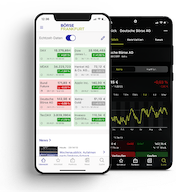ETFs: “Swap operations for US index funds”

The cost reduction implemented almost a year ago has noticeably stimulated demand for a US index fund. Bond ETFs are becoming increasingly popular. Interest in actively managed ETFs is also increasing from a relatively low level.
15 October, FRANKFURT (Börse Frankfurt). At the start of quarterly reporting in the US, optimism prevails among investors in ETF trading. “With equity markets holding up well, we had around 70 percent more buys than sells with slightly lower turnover,” summarizes Holger Heinrich from Baader Bank. Frank Mohr from Société Générale speaks of a “pretty good week” and also of a buying overhang. “However, this is no longer quite as strong as the average of recent months”.
Trading continues to be dominated by the strong interest in global and American share indices, which account for 60 percent of Société Générale's total turnover. According to Mohr, one reason for this could be the increasing demand for savings plans, which are often used to strengthen retirement provision. “Broadly diversified indices are particularly popular here,” explains the trader. The iShares Core MSCI World (IE00B4L5Y983) is attracting a lot of buying interest. Heinrich reports purchases of the Xtrackers MSCI World ex USA (IE0006WW1TQ4) and the Amundi Prime All Country World (IE0003XJA0J9).

Cost advantages have a positive effect
In the ranks of US index funds, there were again strong purchases of the SPDR S&P 500 (IE00B6YX5C33), also known as the “Spider”, while there were some outflows from comparable ETFs. “It looks as if there are targeted swaps here,” Mohr suspects with a view to the significant reduction in fees for the ‘Spider’ almost a year ago. Since then, the number of ETFs sold has almost doubled, while many competing products have reported comparatively moderate growth in the number of units sold. In the past week, sales of the Vanguard S&P 500 (IE00B3XXRP09) and the BNP Paribas Easy S&P 500 (FR0011550185) even outweighed sales. “The costs of these products are also very low, but for institutional investors in particular, every basis point of fees probably counts,” explains Mohr.

Active trading with China ETFs
Lang & Schwarz's trading-savvy clients are currently taking advantage of the strong fluctuations on the Chinese stock markets. “There is a lot of trading in both directions,” reports Andreas Schröer. The focus is primarily on the iShares MSCI China A (IE00BQT3WG13) and the HSBC Hang Seng TECH (IE00BMWXKN31). The trader also registered “a lot of business on both sides” for the iShares Core MSCI EM IMI (IE00BKM4GZ66).
The tech segment remains the clear leader in terms of turnover in sector ETFs. However, Mohr also sees “some profit-taking” with an unchanged buying overhang. While the iShares S&P 500 Information Technology Sector (IE00B3WJKG14) and the Xtrackers Artificial Intelligence & Big Data (IE00BGV5VN51) are primarily bought, the Amundi S&P Global Information Technology ESG (IE000E7EI9P0) is predominantly sold.
Bonds: very short and very long
Bond ETFs are attracting increased interest in the current environment. In addition to the “overnight products” (LU0290358497 and <SR0010510800>), which have been very popular for many months, index funds targeting long-dated bonds are also being traded diligently. Mohr reports some purchases of the iShares USD Treasury Bond 20+yr (IE00BD8PGZ49) and the Amundi US Treasury Bond 7-10Y (LU1407888137). “Everything seems to be moving a bit in the direction of the USA”.
Interest in cryptocurrencies is currently largely limited. However, some investors are continuing to take advantage of the relatively high volatility in this segment to invest. Ivo Orlemann, trader at ICF Bank, reports purchases of the 21Shares Ripple XRP (CH0454664043). This index fund has hardly moved at all over the course of the year, but has repeatedly offered opportunities for short-term trades with a fluctuation range of 11 to 19 euros.
Lively
With a share of around two percent of total European ETF assets, the actively managed ETF segment is still a niche market. However, Ivan Durdevic from J.P. Morgan Asset Management sees great potential here. “Now that active ETFs have established themselves among professional investors, we can expect to see a strong increase in demand from private investors as well”. He sees the “combination of active management with the flexibility, user-friendliness and lower costs of the ETF shell” as decisive advantages. There is no shortage of choice. Since 2020, more active than passive ETFs have been launched worldwide, and the market for active ETFs has almost doubled annually over the past five years.
Mohr reports from Société Générale's trading department that active ETFs are actually being traded “significantly more”, but “do not yet come close” to the top turnover of traditional index funds. The JPM US Research Enhanced Index Equity (ESG), which is trading at an all-time high, has recently been in relatively high demand. The aim here is to outperform the S&P 500 (TR) as a benchmark market in the long term through a “fundamental bottom-up stock selection process” (IE00BF4G7076).
By Thomas Koch, 15. October 2024, © Deutsche Börse
About the author
Thomas Koch is a CEFA investment analyst, investment specialist for structured products and a certified certificate consultant. He has been a freelance journalist covering events on the capital markets since the beginning of 2006.
Feedback and questions to redaktion@deutsche-boerse.com





